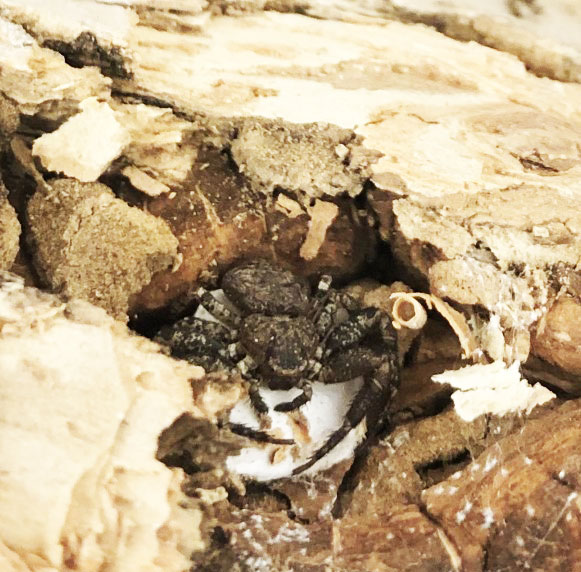Crab Spider: Family Thomisidae

Figure 1: Crab spider on a spruce needle. Photo by L. Kerzicnik
Crab spiders in the Family Thomisidae are aptly named for their crab-like appearances and movements. They stalk or ambush their prey, so they don’t rely on silk webs to capture insects. Some crab spiders, such as the goldenrod crab spider and others in the genera Misumenoides and Misumena, inhabit flowers and stalk pollinators and have the ability to change color to match the substrate. Other crab spiders, such as those in the genus Xysticus, are commonly found in leaf litter, grasses, or other ground cover. Crab spiders feed on a variety of prey and are known as generalist predators. Unlike most spiders, they can kill prey several times their size (such as bumble bees). Some crab spiders are also known to feed on plant nectar.

Figure 2: Female crab spider guarding her egg sac within the bark of an ash tree. Photo by L. Kerzicnik
Life Cycle:
Most crab spiders have a one-year life cycle. Adults are typically active during the summer months. The adults will mate in the fall, and the females will lay an egg sac to overwinter. The spiderlings will hatch the following spring. Crab spiders are harmless to humans and pets. They are beneficial, feeding on many pest insects.
To learn more about the topics discussed on this page, contact the Schutter Diagnostic Lab. If you suspect an infestation on your property, contact your local extension agent, the Schutter Diagnostic Lab at Montana State University, or the Montana Department of Agriculture.
This December fact sheet is also available as a printable PDF (400 KB).
Disclaimer: These recommendations are provided only as a guide. It is always the pesticide applicator’s responsibility, by law, to read and follow all current label directions for the specific pesticide being used. The authors and Montana State University assume no liability resulting from the use of these recommendations. The Montana State University Extension Service is an ADA/ EO/AA/Veteran’s Preference Employer and Provider of Educational Outreach.
